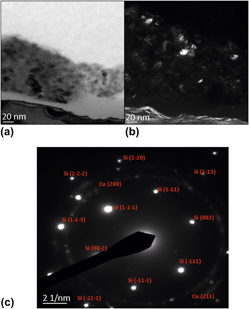Crossref Citations
This article has been cited by the following publications. This list is generated based on data provided by
Crossref.
Singh, Rajendra
Alapatt, Githin Francis
and
Lakhtakia, Akhlesh
2013.
Making Solar Cells a Reality in Every Home: Opportunities and Challenges for Photovoltaic Device Design.
IEEE Journal of the Electron Devices Society,
Vol. 1,
Issue. 6,
p.
129.
Hsu, Feng-Hao
Wang, Na-Fu
Tsai, Yu-Zen
Chien, Ming-Hao
Houng, Mau-Phon
and
Huang, Chien-Jung
2014.
Improvement of Short‐Circuit Current Density in p‐Ni1−xO:Li/n‐Si Heterojunction Solar Cells by Wet Chemical Etching.
Journal of Nanomaterials,
Vol. 2014,
Issue. 1,
Wu, Fan
and
Yao, Nan
2015.
Advances in windowed gas cells for in-situ TEM studies.
Nano Energy,
Vol. 13,
Issue. ,
p.
735.
Elfadill, Nezar G.
Hashim, M. R.
and
Thabit, K. A. Th.
2015.
The role of using seed-layer assisted electrodeposition method on the growth and the photovoltaic properties of p-Cu2O/n-Si heterojunctions.
Journal of Materials Science: Materials in Electronics,
Vol. 26,
Issue. 2,
p.
985.
Bergerot, Laurent
Jiménez, Carmen
Chaix-Pluchery, Odette
Rapenne, Laetitia
and
Deschanvres, Jean-Luc
2015.
Growth and characterization of Sr-doped Cu2O thin films deposited by metalorganic chemical vapor deposition.
physica status solidi (a),
Vol. 212,
Issue. 8,
p.
1735.
Wu, Fan
and
Yao, Nan
2015.
Advances in sealed liquid cells for in-situ TEM electrochemial investigation of lithium-ion battery.
Nano Energy,
Vol. 11,
Issue. ,
p.
196.
Jiang, Xishun
Lin, Qibin
Zhang, Miao
Song, Xueping
and
Sun, Zhaoqi
2015.
Effect of temperature and additive on the structural, morphological and optical properties of Cu2O thin films.
Optik,
Vol. 126,
Issue. 24,
p.
5544.
Huo, Wenxing
Shi, Jin’an
Mei, Zengxia
Liu, Lishu
Li, Junqiang
Gu, Lin
Du, Xiaolong
and
Xue, Qikun
2015.
High-index Cu2O (113) film on faceted MgO (110) by molecular beam epitaxy.
Journal of Crystal Growth,
Vol. 420,
Issue. ,
p.
32.
Hsu, Feng-Hao
Wang, Na-Fu
Tsai, Yu-Zen
Chien, Ming-Hao
and
Houng, Mau-Phon
2015.
Effect of sputtering power on the performance of p-Ni1−xO:Li/n-Si heterojunction solar cells.
Journal of Materials Science: Materials in Electronics,
Vol. 26,
Issue. 2,
p.
755.
Wong, Terence
Zhuk, Siarhei
Masudy-Panah, Saeid
and
Dalapati, Goutam
2016.
Current Status and Future Prospects of Copper Oxide Heterojunction Solar Cells.
Materials,
Vol. 9,
Issue. 4,
p.
271.
Uschakov, А.V.
Karpov, I.V.
Lepeshev, А.А.
and
Petrov, M.I.
2016.
Plasma-chemical synthesis of copper oxide nanoparticles in a low-pressure arc discharge.
Vacuum,
Vol. 133,
Issue. ,
p.
25.
Lindberg, Per F.
Riise, Heine N.
Bergum, Kristin
Svensson, Bengt G.
and
Monakhov, Edouard V.
2016.
Electronic properties of Au/Cu<inf>2</inf>O/n-type Si heterojunction for energy conversion.
p.
2807.
Selman, Abbas M.
Mahdi, M.A.
and
Hassan, Z.
2017.
Fabrication of Cu2O nanocrystalline thin films photosensor prepared by RF sputtering technique.
Physica E: Low-dimensional Systems and Nanostructures,
Vol. 94,
Issue. ,
p.
132.
Takiguchi, Yuki
Takei, Yutaro
Nakada, Kazuyoshi
and
Miyajima, Shinsuke
2017.
Fabrication and characterization of sputtered Cu2O:N/c-Si heterojunction diode.
Applied Physics Letters,
Vol. 111,
Issue. 9,
Kennedy, E. L.
Coulter, J. B.
Birnie, D. P.
and
Cosandey, F.
2017.
Ceramic Materials for Energy Applications VI.
Vol. 37,
Issue. ,
p.
103.
Bouderbala, Ibrahim Yaacoub
Herbadji, Abdelmadjid
Mentar, Loubna
Beniaiche, Abdelkrim
and
Azizi, Amor
2018.
Optical Properties of Cu2O Electrodeposited on FTO Substrates: Effects of Cl Concentration.
Journal of Electronic Materials,
Vol. 47,
Issue. 3,
p.
2000.
Bhunia, R
Dolai, S
Dey, R
Das, S
Hussain, S
Bhar, R
and
Pal, A K
2018.
Fabrication and characterization of Cu/Cu2O/CuO/ZnO/Al–ZnO/Ag heterojunction solar cells.
Semiconductor Science and Technology,
Vol. 33,
Issue. 10,
p.
105007.
Dolai, Sukdev
Dey, Rajkumar
Hussain, Shamima
Bhar, Radhaballav
and
Kumar Pal, Arun
2019.
Photovoltaic properties of F:SnO2/CdS/CuO/Ag heterojunction solar cell.
Materials Research Bulletin,
Vol. 109,
Issue. ,
p.
1.
Bhaduri, Ayana
and
Kajal
2019.
Facile synthesis and characterization of cupric oxide (CuO) nanoparticles: Inexpensive and abundant candidate for light harvesting.
Vol. 2093,
Issue. ,
p.
020047.
Koiki, Babatunde A.
Orimolade, Benjamin O.
Zwane, Busisiwe N.
Nkosi, Duduzile
Mabuba, Nonhlangabezo
and
Arotiba, Omotayo A.
2020.
Cu2O on anodised TiO2 nanotube arrays: A heterojunction photoanode for visible light assisted electrochemical degradation of pharmaceuticals in water.
Electrochimica Acta,
Vol. 340,
Issue. ,
p.
135944.
